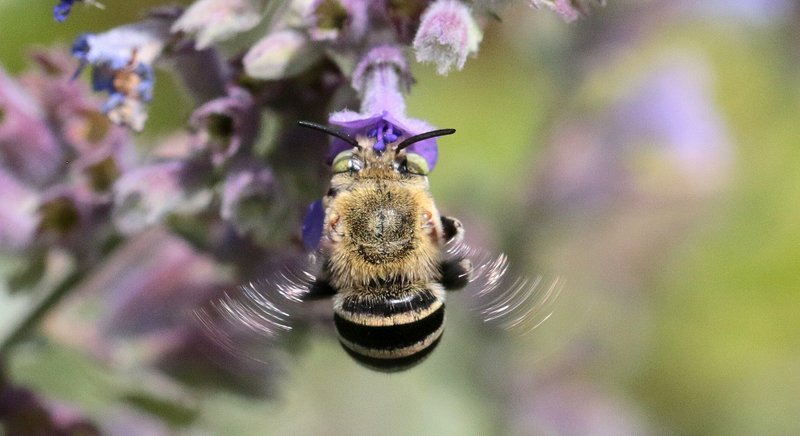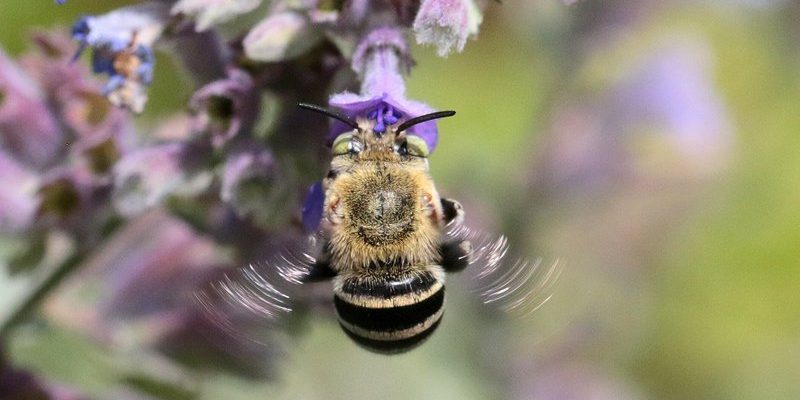
But why the blue-banded bee? Well, these insects are native to Australia and well-known for their striking blue stripes. They’re amazing pollinators, especially for plants like tomatoes and eggplants. By encouraging them to visit your garden, you not only enhance its beauty but also boost the health and yield of your plants. Let me explain how you can set the stage for these charming bees.
Understanding Blue Banded Bees
First things first: you might be wondering what exactly blue-banded bees are. These guys are solitary bees, which means, unlike honeybees, they don’t live in hives. Instead, each female builds her own nest, often in the ground or in hollow stems. You’ll recognize them by their distinctive blue markings and their unique, buzzing flight pattern.
They play an essential role in pollinating native Australian plants, but they’ve also adapted to many garden flowers. These bees are particularly good at “buzz pollination,” a process that involves shaking pollen out of flowers, making them especially effective for certain types of plants.
Here’s the thing: creating an inviting space for blue-banded bees isn’t as hard as it seems. With just a few thoughtful changes in your garden, you can make it a bee haven.
Choose the Right Plants
To attract blue-banded bees, you’ll want to pick plants that they love. Here’s a list of some favorites:
- Native Flowers: Choose plants like the bluebell or kangaroo paw, which are native to Australia and appealing to these bees.
- Herbs: Many herbs like rosemary and thyme are fantastic for attracting bees.
- Fruit-Bearing Plants: Flowers from plants like blueberries and tomatoes are particularly attractive to blue-banded bees.
- Perennials: Plants like lavender or echinacea not only look great but also provide a continuous bloom through the seasons.
Planting a variety of these flowers will keep your garden buzzing with activity. You might be surprised at how quickly the bees respond to these colorful invitations!
Provide Nesting Sites
You might be wondering why it’s essential to think about nesting sites. Blue-banded bees are solitary, and they need safe places to lay their eggs and build nests. You can help them out here!
Consider the following tips:
- Leave Areas Bare: These bees often burrow into the ground. Leaving some areas of bare soil will help them find suitable nesting spots.
- Build Bee Hotels: Creating or purchasing bee hotels filled with hollow stems can provide a cozy place for these bees to nest.
- Plant Dense Clusters: Grouping flowers close together not only attracts more bees but also provides them with a natural habitat.
By taking these steps, you’re giving blue-banded bees a secure home, which might encourage them to stick around.
Avoid Chemical Pesticides
If you’re keen on attracting blue-banded bees, it’s vital to keep chemicals out of your garden. Many common pesticides can be harmful to bees. Here’s what you can do instead:
- Opt for Natural Remedies: Instead of chemical pesticides, consider organic solutions like neem oil or insecticidal soap, which are less harmful.
- Promote Healthy Soil: Healthy soil leads to strong plants, which can naturally ward off pests without the need for chemicals.
- Encourage Beneficial Insects: Ladybugs and lacewings are natural pest controllers that can help keep your garden healthy.
By creating a safe, chemical-free environment, you’re setting the stage for a buzzing backyard oasis.
Provide Water Sources
Just like us, blue-banded bees need water to survive. Providing a water source in your garden can attract them and keep them around. Here’s how:
- Shallow Bowls: Fill shallow bowls with water and add some small stones or marbles. This gives the bees a safe place to land and drink.
- Birdbaths: A birdbath filled with water can be an excellent option, as long as it’s shallow enough for the bees.
- Add Plants: Watering plants helps create moisture in the air, which can naturally attract bees looking for hydration.
Placing water sources around your garden not only helps bees but also other pollinators and wildlife, creating a thriving ecosystem.
Be Patient and Observant
Attracting blue-banded bees isn’t an overnight process, so it’s essential to be patient. You might not see immediate results, and that’s okay! Here are a few things to keep in mind:
- Monitor Your Garden: Spend some time observing your plants. You may notice bees starting to visit, especially during blooming seasons.
- Keep Records: Jot down which plants attract bees the most; this will help you plan better for the next year.
- Adjust as Needed: If a particular plant isn’t attracting bees, consider switching it out for something more appealing.
With time and care, your garden can become a buzzing hotspot for blue-banded bees.
Enjoy the Buzz!
Creating a welcoming environment for blue-banded bees is a rewarding endeavor. Not only do you get to enjoy gardening, but you also participate in supporting these vital pollinators. As you cultivate your space with the right plants, provide nesting sites, avoid harmful chemicals, offer water, and stay patient, you’re setting the foundation for a beautiful, buzzing garden.
So grab your gardening gloves, and start making your space inviting for these amazing bees. The next time you’re in your garden, you might just hear the gentle hum of blue-banded bees. That sounds like a win-win to me!

